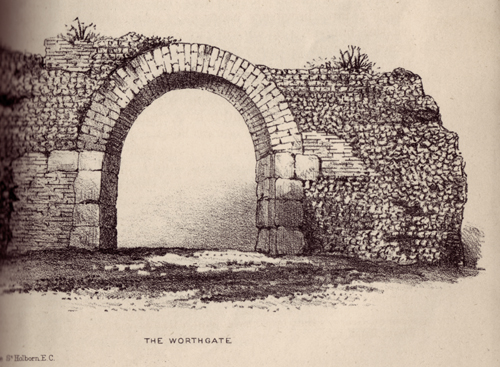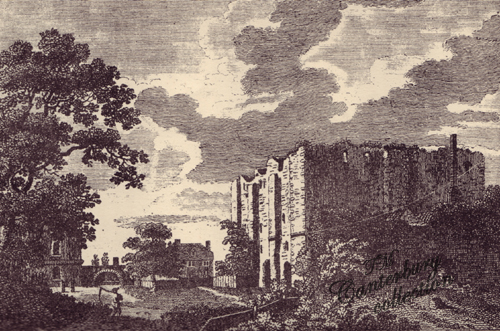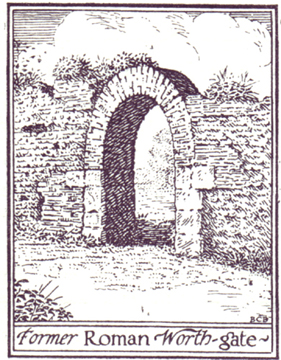
![]()
~ WORTH GATE ~
THE WORTHGATE
CANTERBURY

Drawing from John Brent F.S.A, 1879
".. Among the masterly plates exhibited in this second part, we are very glad to find good views of Wrotham, Frindsbury, and Chatham churches; the very fine Roman arch of Worth-Gate at Canterbury, which is now doubly curious, as it is on the eve of being taken down; the old Gates of the Black & White Friars in that city; two picturesque views of Whornes.... (Bibliotheca Topographica Britannica - Illustrated by John Thorpe) 1793 GM Vol. 53
"Numerous relics of British and Roman antiquity have been discovered. Among the latter are aqueducts, tessellated pavements, vases, and coins; and a Roman arch, called Worthgate, considered to be one of the finest and most ancient structures of the kind in England, has been carefully removed from that part of the castle yard which was crossed by the new road from Ashford, and re-constructed in a private garden." A Topographical dictionary of England 1848
This arch, built entirely of Roman or British bricks, was in 1790 removed, as entire as possible, into the garden of Mr. John Reader, Lamb lane; but was afterwards purchased by the late Thomas Barrett, Esq. and removed to his seat at Lee Priory, and now forms the arched gateway leading into the grounds of that delightful residence. WG
"One cemetary on the east, runs under and on both sides of the road now called "Old Dover Road;" part of it was subsequently used as the graveyard of St. Sepulchre's Nunnery. A second Roman cemetery was found outside Worth Gate. It was adjacent to the site of the Chatham and Dover Railway Station, and extended into Wincheap field, beyond the Gasometer. A third cemetery was on the St. Dunstan's Road. It included the site of St. Dunstan's Churchyard, but it extended from the South Eastern Railway cutting to the London Road on the north-west. A fourth cemetery was found a Vauxhall, beside the Ramsgate Road. It included the sites of the Infantry and Cavalry Barracks. A fifth seems to have been near Little Barton and the cemetery of St. Augustine's Abbey. (See Brent's Canterbury in the Olden Time, 2nd Edition, pp. 31-33, 38-41) AC 1883
The late John Thorpe, Esq. of Bexley, has thus described it in the first part of his Antiquities in Kent. "Worth-gate is, without a doubt, the finest remnant of antiquity in this city, and perhaps the most entire of its kind in the kingdom. The boldness of the arch, consisting entirely of Roman bricks, strikes the eye of the beholder with a kind of veneration. In the inside, next to the castle-yard, the ground has been raised so much from time to time, that no more than one foot six inches of the stone piers, or columns to the springs of the arch, are now to be seen; but when viewed on the garden side in the city ditch, the gate makes a noble appearance, as the height of the piers is seven feet six inches. These piers are composed of a kind of rag-stone, two feet six inches in breadth, which appear to have been squared, but are now irregular and uneven, from being much corroded, and mouldered away, through the great length of time; whilst the arch, which consists of a double row of bricks, remains as fine and durable as ever; so well had the Romans the art of tempering and burning their clay. The length of the longest brick, on the Castle side, is one foot five inches; the depth of the thickest, three inches. The following measurements I took in the year 1771; in the inside, the diameter of the arch is 12 feet 3 1/2 inches; it springs from the piers 6 feet, and half an inch; the piers are above ground, 1 foot 6 inches. On the ditch side, the height of the plinth is one foot; from that to the spring of the arch, 6 feet 6 inches; breadth of the gateway, from pier to pier, 12 feet 6 inches; height of the gate in the middle, 13 feet 7 1/2 inches; thickness of the arch, 2 feet 4 inches: the earth raised on the castle side, 6 feet." This account is illustrated by two views of the opposite sides of the gate.
The new road to Ashford, that was made by public subscription about the year 1790, crosses what was formerly the Castle yard, and passes over the site of the ancient Roman arch, called Worth-gate, which was removed on that occasion.
"The passage from the city to the castle was anciently by a bridge, and beyond that a gate, built at the north entrance of the bayle; and on the opposite side, towards the country, in the wall (it being the city wall likewise) was the ancient city gate, called Worthgate, the remains of which were nearly entire till within these few years, when it was taken down and removed into the garden of a neighbouring citizen; the appearance of it, carried a greater show of antiquity than the castle itself, in the perfectly circular arch of long British or Roman bricks of great strength and beauty. This arch was repaired some years ago, out of veneration for its antiquity, by Dr. Gray, an eminent physician of Canterbury. It was supposed to be one of the most entire Roman arches in the kingdom. The ground on the side next to the castle had risen to within eight feet eight inches of its summit; it was made entirely of bricks, set edgeways, each fifteen inches and a half long, and one inch and a half thick; the diameter was twelve feet three inches and a half, and the base within twelve feet six inches.
Through this gate the passage seems to have led in the time of the Romans, over the Stone-street way, to the portus lemains, and afterwards as the public way from the city to Ashford, and elsewhere, until it was diverted by another course, and this gate reserved solely for the use of the castle, and as such it continued till at Wyatt's insurrection, in Queen Mary's reign, when it was closed up, for the better security of the castle, from any assaults in these critical and dangerous times." HT

You can see what I believe is possibly the Worthgate on the left hand side of the castle, just behind the man with the scythe
Numerous relics of British and Roman antiquity have been discovered; among the latter are, aqueducts, tesselated pavements, vases, and coins; and a Roman arch called Worthgate, considered to be one of the finest and most ancient structures of the kind in England, has been carefully removed from that part of the castle yard which was crossed by the new road from Ashford, and reconstructed in a private garden.* TD 1831
* my notes - taken down 1791, moved to Lee Priory in Littlebourne (demolished again in the rebuilding of that home)
"In the city wall at Worthgate, now walled up, which was the ancient road from Castle street to Chilham, is a Roman arch. (Nichols's Bibliotheca Topographica Britannica, I, 1790.)" NC 1852

Drawing from Canterbury a History of the Ancient City c. 1905
"Of the Worthgate there remains no vestiges above ground. It stood at or near the courtyard of the Castle; not, however, necessarily connected with the Castle, but as a mode of egress from the city. Its exact site was probably in Castle Street, in a line with the outer wall of the Castle, S.W.; but some excavations which the writer of this work proposed to make at his own expense to decide its claim to a Roman origin were prohibited by the city authorities, upon what principles no one seems exactly to comprehend. It was a question intimately connected with the boundaries of Canterbury itself under the Romans, and might have decided an important controversy, and was in this respect, as well as in increasing our knowledge of the ancient boundaries of the city, a question of utility. This gate, which is alluded to by Dr. Stukeley as partly of a Roman character, was pulled down in 1791.* It was removed piecemeal to a garden in Canterbury bordering on the River Stour, and then re-erected after a certain fashion. It then again migrated to the park at Lee Priory, where it was set up. It has, however, long since disappeared. The late Sir Egerton Brydges has given an engraving of it, rather of a gate composed of its remains, in one of the works which issued from the Lee Priory Press.** COT
*At the same time a new road was made from Wincheap across the Castle dike and yard in to the city by Castle Street. To effect this, the Corporation, by an exchange with Mr. J. Balderson, acquired a sufficient portion of the Castle yard to carry out their design. The year previous, the Corporation had obtained an Act of Parliament to make a direct road from St. George's Gate by a new causeway, thence dominated the New Dover Road.
**Hasted says the Worthgate was removed in its integrity. The diameter of the arch was 12 feet 3 inches. Two, if not three, gateways are engraved as ornamental sketches in the books printed at the Lee Priory Press; none of these, however, have the characteristics of Roman work, nor do any of them agree with the engraving of Dr. Stukeley.
"This gate was situated near the Castle, hence the name Worth, signifying a fort; it being thought unsafe that the public road should lead though the bayle of the castle it was taken down and another erected, which was known as Wincheap-gate. This was also demolished, to make the passage more suitable for the public traffic." GG 1890's
The gate was a Roman structure, having an arch made of possibly 100 tiles with large stone jambs. The jambs were likely made out of oolite as in many of the other structures we see in Canterbury. The medieval name for the gate was Worgate, the "th" was added on in later centuries.